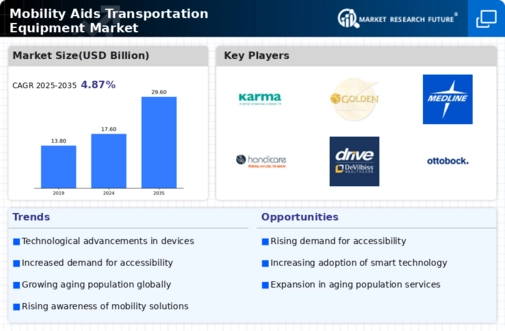Aging Population
The Global Mobility Aids Transportation Equipment Market Industry is significantly influenced by the increasing aging population worldwide. As individuals age, mobility challenges often arise, necessitating the use of mobility aids. By 2024, the market is projected to reach 17.6 USD Billion, driven by the demand for wheelchairs, scooters, and other assistive devices. Countries with higher proportions of elderly citizens, such as Japan and Italy, are particularly notable examples where mobility aids are essential for maintaining independence. This demographic shift suggests a sustained growth trajectory for the industry, as the need for accessible transportation solutions becomes more pronounced.
Government Initiatives
Government initiatives aimed at improving accessibility for individuals with disabilities significantly impact the Global Mobility Aids Transportation Equipment Market Industry. Various countries are implementing policies and funding programs to support the acquisition of mobility aids. For example, the United States has established grants and subsidies to assist individuals in obtaining necessary equipment. Such initiatives not only enhance the quality of life for users but also stimulate market growth by increasing demand. As governments recognize the importance of inclusivity, the market is expected to expand, aligning with broader societal goals of accessibility and mobility for all.
Market Growth Projections
The Global Mobility Aids Transportation Equipment Market Industry is poised for substantial growth, with projections indicating a market size of 17.6 USD Billion in 2024 and an anticipated increase to 29.6 USD Billion by 2035. This growth trajectory reflects a compound annual growth rate (CAGR) of 4.88% from 2025 to 2035. Such figures underscore the increasing demand for mobility aids driven by various factors, including an aging population, technological advancements, and government initiatives. The market's expansion is indicative of a broader societal commitment to improving mobility and accessibility for individuals with disabilities.
Technological Advancements
Technological innovations play a crucial role in shaping the Global Mobility Aids Transportation Equipment Market Industry. The integration of smart technologies, such as IoT and AI, enhances the functionality and user experience of mobility aids. For instance, electric wheelchairs equipped with navigation systems and remote control capabilities are becoming increasingly popular. These advancements not only improve user convenience but also contribute to safety and efficiency. As the market evolves, it is likely that these technologies will lead to a more robust growth rate, potentially increasing the market size to 29.6 USD Billion by 2035, reflecting a CAGR of 4.88% from 2025 to 2035.
Rising Awareness of Disability Rights
The growing awareness of disability rights and the importance of mobility aids is reshaping the Global Mobility Aids Transportation Equipment Market Industry. Advocacy groups and non-profit organizations are actively promoting the rights of individuals with disabilities, leading to increased demand for mobility solutions. This heightened awareness encourages manufacturers to innovate and improve their product offerings, ensuring they meet the diverse needs of users. As societal attitudes shift towards inclusivity, the market is likely to experience sustained growth, driven by a collective commitment to enhancing mobility for individuals with disabilities.
Urbanization and Infrastructure Development
Urbanization and infrastructure development are pivotal factors influencing the Global Mobility Aids Transportation Equipment Market Industry. As cities expand and populations grow, the demand for accessible transportation solutions increases. Urban areas are increasingly focusing on creating inclusive environments, which often includes the integration of mobility aids into public transportation systems. For instance, cities are investing in accessible buses and trains, which facilitate the use of mobility aids. This trend not only enhances the quality of life for users but also drives market growth as more individuals seek reliable transportation options.










